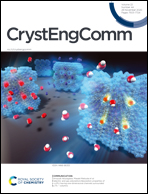Nuclearity control in calix[4]arene-based zinc(ii) coordination complexes†
Abstract
Three zinc-based coordination complexes were selectively generated in the crystalline phase using a new flexible molecular “tweezers” calix[4]arene derivative ligand decorated with two appended carboxylic moieties and benzyl spacers (3-4H). Through the control of the metal/ligand ratio and the synthetic conditions, the coordination sphere around the zinc cations was found to be different, which influenced the nuclearity of the obtained complexes. The mononuclear complex (3-3H)2–Zn(DMF)2 was obtained, while two partially deprotonated ligands (3-3H)− cap the metallic cation, leading to a nontubular “8”-shaped structure with a metal/ligand ratio equal to 1/2. The dinuclear (3-2H)2–Zn2py4 complex displays a tubular structure with a metal/ligand ratio equal to 1/1, where two zinc cations act as a linear metal linker between two (3-2H)2− species, which adopts a cone conformation. Finally, the third trinuclear coordination complex (3-2H)4-Zn3(OH2) was obtained using (3-4H) and the highly coordinating sulfonylcalix[4]arene (4-4H), exhibiting a 3/1/1 metal/3/4 ratio. Thus, it has been demonstrated that under self-assembly conditions, the nuclearity of the new complexes based on zinc cations and calix[4]arene dicarboxylate (3-4H) can be tuned using different synthetic conditions: nature of solvent, crystallization method, use of a highly coordinating ligand (4-4H).
![Graphical abstract: Nuclearity control in calix[4]arene-based zinc(ii) coordination complexes](/en/Image/Get?imageInfo.ImageType=GA&imageInfo.ImageIdentifier.ManuscriptID=D0CE01232G&imageInfo.ImageIdentifier.Year=2020)
- This article is part of the themed collection: Introducing the CrystEngComm Advisory Board and their research


 Please wait while we load your content...
Please wait while we load your content...